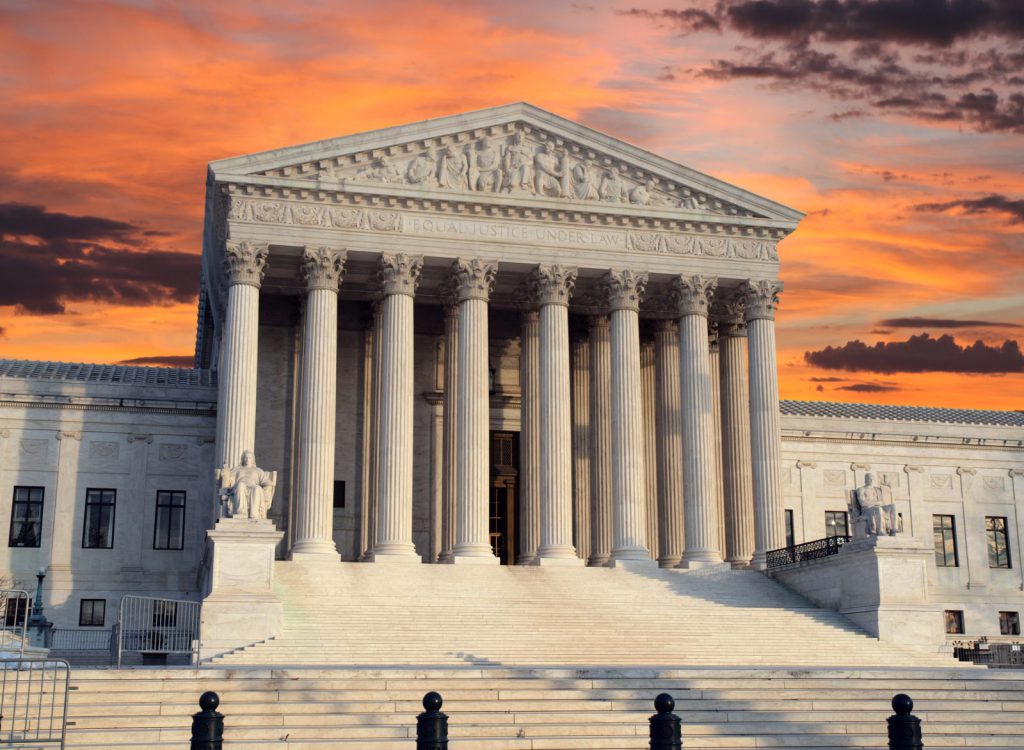
Published July 1, 2018
As many observers have noted, the opportunity to name a replacement for the retiring Justice Anthony Kennedy (and more generally to name a second Supreme Court justice within two years) will help to cement Donald Trump’s influence on the federal judiciary for a generation. If he sticks to his list of potential nominees, and so chooses to take the advice of the conservative legal movement here as he has with judicial nominations more broadly, he will move the Court to the right in a decisive way.
I’ve got my favorites on that list (judges Barrett and Kavanaugh in particular) but it certainly seems like everyone on it would have that effect. It is a very good thing that judicial nominations have been a major exception to the deeply dysfunctional pattern of the Trump Administration’s decision making, and we should all dearly hope that continues.
It also seems to me, however, that one key practical effect of such a change would actually be to cement the judicial legacy and influence of the previous Republican president, George W. Bush. If Justice Kennedy is replaced by a reliable judicial conservative in the mold of Justice Gorsuch, then Chief Justice John Roberts would probably become the swing vote on the Court. And he would swing in response to a different set of priorities than Kennedy’s—a set of priorities that might in time become core concerns of America’s legal and constitutional culture as a result, at least for practical purposes.
In cases where Kennedy’s vote was in question and was decisive, the general (though not perfectly consistent) pattern was that he would swing in the direction of a vaguely libertarian understanding of individual liberty, so that litigants who wanted him on their side would seek out fact patterns and make arguments that might put them on the side of personal autonomy. But when Roberts is unpredictable, it is usually some idea of judicial restraint that is at play.
In this sense, Roberts reflects (or rather seems to share) the distinct priorities of the president who appointed him. When he talked about judicial philosophy, George W. Bush tended to elevate the idea of judicial restraint above originalism or textualism as a way of describing his thinking. He did this routinely in the course of the 2000 and 2004 campaigns and in statements about judicial appointments to both the lower courts and the Supreme Court throughout his presidency. In his memoir, Decision Points, Bush writes that in considering candidates for the federal courts, “[t]he only tests in my mind were personal integrity, intellectual ability, and judicial restraint. I was concerned about activist judges who substituted their personal preferences for the text of the law.”
A friend who worked in the White House counsel’s office during the Bush years once described to me a session in which Bush’s lawyers were discussing with him a memo they’d prepared as a background document for his interviews of potential picks for the seat opened up by the retiring Justice Sandra Day O’Connor. On his copy of the memo, Bush had written and underlined the words “judicial restraint,” and he repeatedly brought up his concern about judicial activism.
This prioritization of restraint was not always applied consistently, of course, but it did seem to be Bush’s emphasis when it came to judicial philosophy. And with this emphasis, whether he intended to or not, Bush was taking a side in a significant dispute within the conservative and libertarian legal movement between advocates of different understandings of constitutional originalism. The more libertarian among right-leaning lawyers now strongly incline toward an originalist form of judicial activism (which they sometimes call “judicial engagement”) by which judges should assertively advance a defense of the rights that lay at the core of the American conception of government. More traditionally conservative right-leaning lawyers tend to prefer a less activist judiciary and to broadly identify originalism with restraint and with some deference to the elected branches.
This argument continues to rage, and Trump’s list of 25 potential Supreme Court picks includes some on both sides of the divide. But in no small part thanks to Bush’s emphasis on restraint, it’s the more minimalist conservatives who still dominate the ranks of Republican-appointed judges. Both of Bush’s Supreme Court appointments—Roberts and Alito—tend to prefer distinct forms of judicial minimalism, while no one else on the Court prioritizes restraint nearly as much. And if Roberts now becomes the deciding vote in close cases, that preference could transform the character of our most contentious legal disputes.
Justice Alito’s form of judicial minimalism tends (very broadly speaking) to emphasize the space the Constitution affords to state and local self-government and civil society and the restraint this demands of the federal judiciary when it comes to some key public controversies. For Chief Justice Roberts, the emphasis seems more often to be on protecting the legitimacy of the courts, the integrity of our system of government, and the public’s respect for both by limiting the degree to which judges take aggressive action on contentious issues.
As the Hoover Institution’s Adam White recounted in an exceptionally insightful profile of the chief in 2015, Roberts has made this view pretty explicit for many years. Even long before he was a judge, during his time as a Department of Justice official in the Reagan years, Roberts prepared notes for a “draft article on judicial restraint,” which were made public before his Senate confirmation hearings. “When courts fail to exercise self-restraint and instead enter the political realms reserved to the elected branches,” he wrote back then, “they subject themselves to the political pressure endemic to that arena and invite popular attack.” Other early writings of his consistently stressed this theme too. He emphasized it in his confirmation hearings, and it has also been both explicit and implicit in some of his key opinions on the Court—perhaps most notably in his strained efforts to uphold Obamacare’s individual mandate to avoid overturning the law in 2012.
This suggests that as Roberts becomes the Court’s key swing vote—which, as the New York Times noted last week, has already begun to happen in the last couple of years and now seems likely to accelerate rapidly in Kennedy’s absence—the question of judicial activism and judicial minimalism will move to the center of how key constitutional and legal disputes are understood and discussed. Litigants who want the chief on their side in a divided court will work hard to present their desired outcomes as the less activist moves for the court.
In areas where constitutional litigation is highly strategic (the abortion debate comes to mind above all) we can expect strategists on all sides to seek out cases and pursue litigation in ways that will present their views as the less aggressive, more incremental, and more restrained of the options before the Court. The pro-life movement has been giving thought to strategy along these lines for some years now, in the hope of a turn in this direction on the Court.
Some of the key state-legislative strategies regarding abortion in recent years (particularly those championed in various states by Americans United for Life, one of the legal-strategy arms of the pro-life movement) have been pursued with the aim of enticing a particular kind of legal challenge from the abortion lobby that might enable the Court to chip away at Roe in the name of a restrained federal judicial role rather than in the name of an aggressive assertion of judicial authority. That kind of strategy could well pay dividends now.
And more generally, we might find various activists on all sides of key disputes seeking to appeal to the Chief Justice by insisting they are on the side of a restrained judiciary where until now they might have tried instead to appeal to Justice Kennedy by insisting they were on the side of personal autonomy.
Such a change would be welcome, to be sure. And it would itself be a move to the right. There is no question that a Supreme Court with John Roberts at its center would stand to the right of one with Anthony Kennedy at its center. I suspect that Justice Kennedy’s peculiar kind of personal-autonomy libertarianism has done a lot to shape the way some key arguments in our culture wars are articulated and understood, including well beyond the courts. But it does seem likely, especially if such a change of tone and focus does gradually occur, that we would still be looking at a Supreme Court that swings a fair bit on the most contentious issues—unless of course Trump or another Republican president gets to replace one of the liberal justices.
It is ironic, in this context, that one key rationale for the Chief Justice’s emphasis on judicial restraint is his desire to avoid giving the public the impression that the courts are too politicized. If Roberts’s preference for minimalism becomes a key dividing line in the most hotly contested cases, then it almost cannot help but become a means by which the Court’s decisions do become politicized. If the Chief Justice is looking to keep the role of the Court under control and protect its reputation—which is a fundamentally political aim—and is willing at times to bend his constitutional and legal interpretations to that cause, he would be in effect politicizing the Court’s work in the effort to limit the appearance of politicization. An elite legal culture that takes its cues from such an inclination could easily grow (even more) dangerously solipsistic, while a Court that prioritizes such concerns would likely only look more self-interestedly political and subject itself to only more of exactly the political pressure Roberts wants to avoid.
All of this is guesswork, to be sure. But it does seem to me that rather than assume that replacing Justice Kennedy with a reliably conservative judge will mean that in every case in which there were four justices to Kennedy’s right there will now be an easily predictable majority of five, we should think about where the Court’s swing vote will now be found. And the answer seems very likely to be the less-than-simply-predictable Chief Justice.
— Yuval Levin is the editor of National Affairs and a fellow at the Ethics and Public Policy Center.








